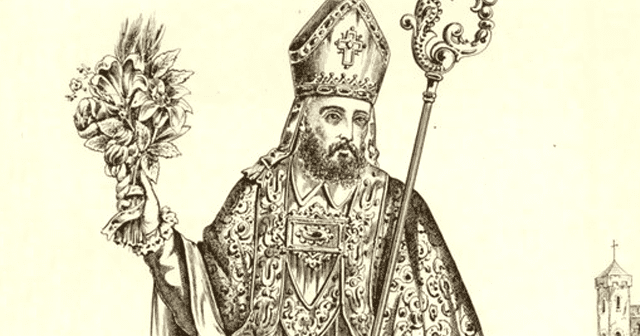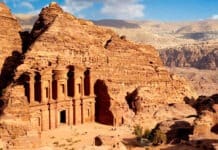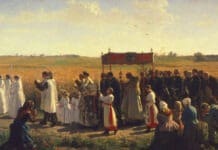The life of Saint Arnulf is known to us by one of his contemporaries. It was published in the “Acta Sanctorum ordinis S. Benedicti” and in the “Scriptora Rerum Merovingicarum.”
Arnulf was born around 580 in Layum castle, today known as Lay-Saint-Christophe near Nancy in the country known as Austrasia . His father was Baudgise (d. 588), Palace Mayor and Duke of Sueve. His mother was Oda. After successful Latin studies, Arnulf was taken under the tutelage of Gondulphe who was either Bishop of Metz or Palace Mayor. Subsequently, Arnulf was recommended to King Theodebert II where he was placed in charge of the palace of government of the province of Moselle.
It was in Moselle around 600 that Arnulf married Dode, daughter of the Count of Boulogne. They had many children, including sons Ansegisel and Clodulf. Clodulf, later St. Cloud, also became a Bishop of Metz. Ansegisel’s descendants include Pepin d’Heristal, Charles Martel, Pepin le Bref and finally Charlemagne.
Arnulf lived during a period of much turmoil in the region. There were many wars, rulers were poisoned, others were captured and tortured to death. It may have been these horrors that caused Arnulf to enter the Church. He was chosen as the 29th Bishop of Metz by the people and the clergy of Metz and enthroned near the end of 612.
His election as bishop ruined his plan to move to the Lernis monastery with his friend Romary. Also around this time, Dode moved to a Benedictine convent near Treves and no more is known about her.
Arnulf played a large role in the Edict of 615 which laid out 2 fundamental laws: It did away with the outright permanence of hereditary land, stating that the nobles had to continue to actively manage the lands to continue their ownership and it decreed that bishops were to be elected by the faithful, not appointed by king.
Arnulf played an important role in the politics of his time, being a close advisor to King Dagobert and participated in the councils of Paris (614), Metz, Reims (625) and Clichy (627). Yet he longed to retire to solitude and did so in 629.
After leaving as bishop, he moved to a mountain near Remiremont where he built a chapel. Here he sheltered lepers and others rejected by society.
His reputation attracted young men who wanted to live a solitary religious life, but Arnulf directed them to his friend Romary’s monastery near Remiremont. Arnulf lived alone at his retreat and died on August 16, 640. Romary conducted his funeral and had him buried at Arnulf’s mountain chapel.
Saint Arnulf is the patron saint of beer and brewers owing to a pious legend about the saint. According to the legend, in July 642 on a very hot day, the parishioners of Metz went to Remiremont to recover the remains of their former bishop. They had little to drink and the terrain was inhospitable.
At the point when the exhausted procession was about to leave Champigneulles, one of the parishioners, Duc Notto, prayed “By his powerful intercession the Blessed Arnulf will bring us what we lack.” Immediately the small remnant of beer at the bottom of a pot multiplied in such amounts that the pilgrims thirst was quenched and they had enough to enjoy the next evening when they arrived in Metz.
The then Bishop of Metz, Goery, Tiffory, the Bishop of Toul and Paul, the Bishop of Verdun, led a procession to Metz where he was reburied at the abbey of Saints Apostles which later became the Abbey of Saint Arnulf. When the abbey was razed in 1552 by the Duke of Guise during the siege of Metz by Charles V, the venerated relics were returned to inside of Metz. The abbey that acquired them named their tower after Saint Arnulf. Today the building is the mess hall for the garrison officers and the road that goes under the building is called “Under Saint Arnulf”.
There are two other legends associated with Saint Arnulf.
In one legend, Arnulf was tormented by the violence that surrounded him and feared that he had played a role in the wars and murders that plagued the ruling families. Obsessed by these sins, Arnulf went to a bridge over the Moselle river. There he took off his bishop’s ring and threw it into the river, praying to God to give him a sign of absolution by returning the ring to him.
Many penitent years later, a fisherman brought to the bishop’s kitchen a fish in the stomach of which was found the bishop’s ring. Arnulf repaid the sign of God by immediately retiring as bishop and becoming a hermit for the remainder of his life.
In the other pious legend, at the moment Arnulf resigned as bishop, a fire broke out in the cellars of the royal palace and threatened to spread throughout the city of Metz. Arnulf, full of courage and feeling unity with the townspeople, stood before the fire and said, “If God wants me to be consumed, I am in His hands.” He then made the sign of the cross at which point the fire immediately receded.


















July 18, 2021
A couple of years ago I found out that St. Arnulf is an ancestor of mine. I traced one ancestor from around the 1700’s to the Marquis Du Bois from around 1575 or so, and from him on down the genealogical work was done. All the links just fell into place. I thought it was really cool that Charlnagne was in my line until I stopped into the LDS Genealogical center, just down the road from Trump Tower in NYC, and the man there told me that about 80% of Western Europeans are descended from Charlgmagne. So it was no big deal after all. But St. Arnulf, he is something different !
Mine as well. I traced him back from what are now the Warren’s or De Varrene. Nice to meet you cuz!